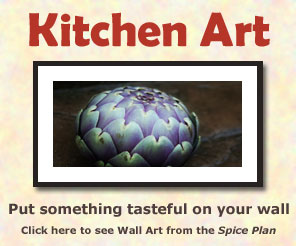Enjoy these articles on basic cooking:
How to Prepare
Before we get to any of our cooking topics, we need to discuss something that is so incredibly obvious, it needs a French name to make it sound more mysterious: Mise en place. This just means that you need to prepare all the food before you even heat a pan. Ignoring this step is where most newbies get burned... sometimes literally. There's nothing quite as funny as watching a novice scramble frantically to chop five items that need to get added before the onions burn. Unless, of course, you have to eat the results.
There really isn't much more to say about this. Read the directions for the recipe before you start, get out all the ingredients you will need and then CHOP EVERYTHING before you so much as touch the burner. It should look just like the cooking shows, with everything in nice piles or in a bunch of small dishes. Of course, if you can enlist another junior chef to help you with the chopping, so much the better.
Now, when you start to cook, you won't break a sweat as you calmly add the proper ingredients at just the right time.
How to Cut an Onion
Yes, I'm going to tell you how to cut an onion. Not that you can't figure it out on your own, but if you're going to start cooking, you're going to cut a lot of onions. When you see a pro do it, you realize that there is only so much time in your life to devote to doing things the wrong way. Here's a fast and efficient technique:
- With a sharp chef's knife, cut through the stem end of the onion, leaving a flap that you can use to rip down and peel off the outer skin.
- Cut any dirty roots off the other end, but don't cut the whole end off. We're going to use that to hold the onion together while we chop it up. With the root end up, cut the onion in half through the root.
- Lay each half of the onion down and make multiple slices from the root to the stem -- but don't cut through the root.
- Turn the onion ninety degrees and make the final cuts across the onion. There will be a small stub at the root end, which you can discard.
How to Sauté
How to Season a Pan
There's nothing like a well-seasoned cast-iron pan to fry or sauté almost anything. But if you've ever seen someone try to scrape an egg off a new iron frying pan, you know there may be, um, issues. That's why so many neophytes toss the fry pan and go buy the teflon version. I can sympathize. Actually, there are some good teflon pans, but you're going to pay for them. And you're going to have to get a bunch of non-scratching utensils so you won't scrape the delicate teflon off. The great benefit of cast iron is that it can hold a ton of heat and it's practically indestructible. That's because it's basically a thick slab of iron. That cheap, thin teflon pan you're looking to buy won't hold its heat. After the first batch of chicken thighs, it will totally poop out. But you can combine the best of both worlds -- heat capacity and slickness -- by properly seasoning your cast-iron. Even a pre-seasoned pan can use this extra love.
Seasoning doesn't mean to hit it with cajun spices, but rather to put a hard coating of oil on it. Hard and oil don't seem to go together, but it's just like lacquering a nice piece of furniture: in a few hours it dries to a nice solid shine. Unfortunately, vegetable oil takes about a year to dry like that, so we accelerate the process with heat. Here's how:
- Put a thin coat of oil (some people swear by lard or bacon fat, but a high-smoke-point oil like canola is fine) on your pan and then wipe up any excess with a paper towel. Too much oil will just create a sticky muck. Oil up the sides too.
- Bake the pan in your oven for an hour or two at about 300 degrees.
- Repeat if necessary to get a smooth surface.
Your pan may need occasional reseasoning, but you should find that it's just as slick as teflon if you do it right. You now have a pan that won't warp, will last until the next ice age and that you can easily pop into the oven. Take that, teflon!
A few notes:
- Don't scrub your pan with a lot of soap and then let it sit around to rust, because it will. In about two minutes! Just rinse it in water and dry it immediately. You might even want to rub a tiny bit of oil on it.
- Get your pan hot before you use it. The heat capacity that allows you to cook batch after batch of chicken thighs needs some time to build up. Water drops will bounce around the pan when it's hot enough. Patience is a virtue.
- Use a hot pad or get a pot-handle holder. That nice part about being able to plop it in the oven? Well, it also involves a hot handle.
